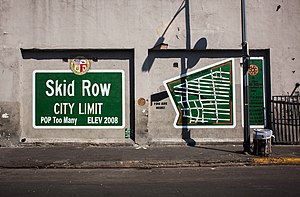
A skid row, also called skid road, is an impoverished area, typically urban, in English-speaking North America whose inhabitants are mostly poor people "on the skids". This specifically refers to people who are poor or homeless, considered disreputable, downtrodden or forgotten by society.[1][2] A skid row may be anything from an impoverished urban district to a red-light district to a gathering area for people experiencing homelessness or drug addiction. In general, skid row areas are inhabited or frequented by impoverished individuals and also people who are addicted to drugs. Urban areas considered skid rows are marked by high vagrancy, dilapidated buildings, and drug dens, as well as other features of urban blight. Used figuratively, the phrase may indicate the state of a poor person's life.
The term skid road originally referred to the path along which timber workers skidded logs.[3] Its current sense appears to have originated in the Pacific Northwest.[4] Areas in the United States and Canada identified by this nickname include Pioneer Square in Seattle;[5] Old Town Chinatown in Portland, Oregon;[6] Downtown Eastside in Vancouver; Skid Row in Los Angeles; the Tenderloin District of San Francisco; and the Bowery of Lower Manhattan. The term Poverty Flats is used for some Western US towns.[7]
The term "skid row" may often be interchangeable with the term tent city. A tent city may exist on the premises of a skid row, but many tent cities are in areas not known as skid rows.
- ^ "Skid Row". Collins English Dictionary – Complete & Unabridged (2012 Digital ed.). HarperCollins. 2012.
- ^ "skid road", Wiktionary, 2021-08-25, retrieved 2022-01-21
- ^ "Skid road". The American Heritage Dictionary of the English Language, Fourth Edition. Houghton Mifflin Harcourt. Retrieved 23 September 2015.
A squalid district inhabited chiefly by derelicts and vagrants. [Alteration of SKID ROAD (from the fact that it once referred to a downtown area frequented by loggers).]
- ^ Cite error: The named reference
NYTswas invoked but never defined (see the help page). - ^ "National Register Information System". National Register of Historic Places. National Park Service. July 9, 2010.
- ^ "Portland's History". Retrieved 2011-10-09.
- ^ U.S. Geological Survey Geographic Names Information System: Grant, Idaho — "The variants, Poverty Flats and Gravy Bend, were acquired during impoverished times when residents had to eat watered-down gravy."
© MMXXIII Rich X Search. We shall prevail. All rights reserved. Rich X Search
